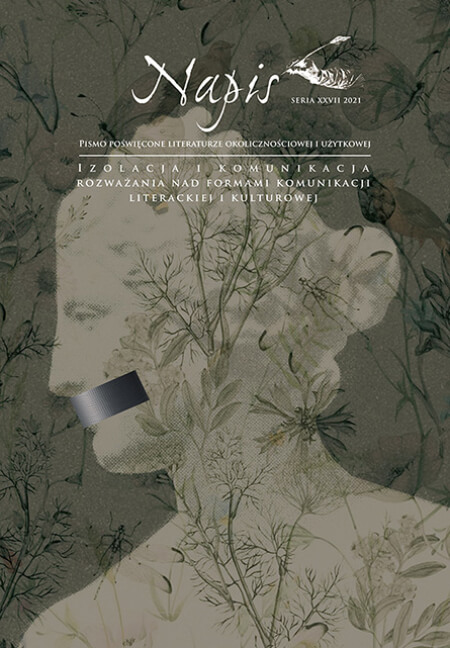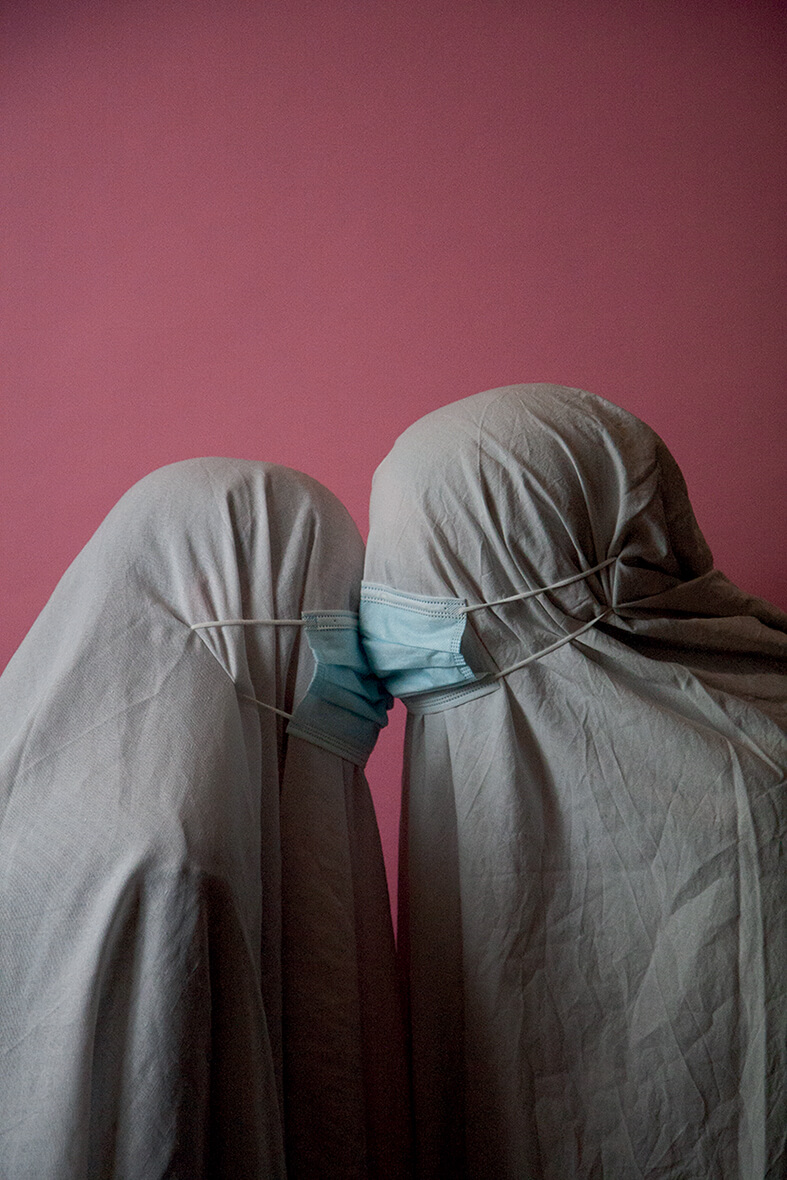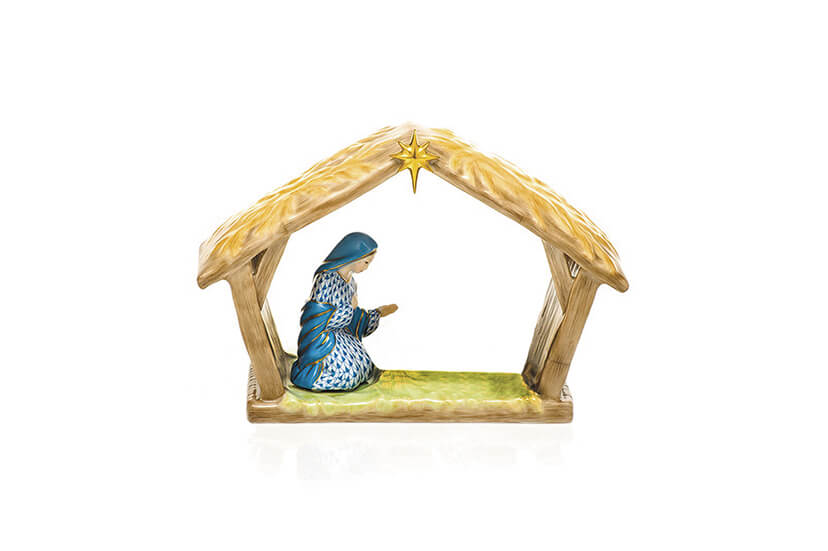Wstęp: Wyspy pełne głosów (Agnieszka Bąbel)
Artykuły zebrane w tym tomie „Napisu” są reakcją na nowe zjawiska kulturowe, związane z restrykcjami wymuszonymi izolacją w dobie pandemii Covid-19 (jak zdalna wymiana informacji, nowe formy pracy i rozrywki online). To traumatyczne doświadczenie można potraktować jako pewien impuls, który uwypuklił określone cechy ludzkiej kultury, psychologii, egzystencjalnej samoświadomości, skłaniając do głębszego spojrzenia na relację człowiek – świat (w tym także: świat przyrody) oraz człowiek – inni ludzie. Mogło też stać się ono inspiracją dla badaczy kultury, antropologów, literaturoznawców czy językoznawców.
W zamieszczonych w XXVII tomie rozprawach pojawiają się bezpośrednie odwołania do – ściśle łączącego się z izolacją, a także z formą komunikacji, jaką jest podróż – motywu wyspy. Motyw ten traktowany jest konkretnie lub symbolicznie, wartościowany pozytywnie lub negatywnie – to na przykład miejsce zesłania, jak wyspa Św. Heleny dla Napoleona w artykule wprowadzającym Jacka Wasilewskiego, porządkującym kwestie izolacji i komunikacji z semiotycznego punktu widzenia i odwołującym się do podstawowych opozycji dobrowolności – przymusu oraz jednostki – grupy; jako topos „wyspy miłości” – rokokowy motyw Cytery u Tomasza Jędrzejewskiego; może być to dobrowolna izolacja alpinistów w tekście Przemysława Kaliszuka lub odosobnienie artysty w rozprawie O Flaubertowym „zakamarku” Beaty Garlej. Po stronie izolacji przymusowej sytuują się analizy doświadczenia jeńców wojennych (artykuł Marcina Pliszki), egzystencji emigrantów, naznaczonej wyobcowaniem kulturowym i próbami nawiązywania dialogu listowego z krajem (prace Małgorzaty Chachaj, Joanny Hałaczkiewicz), aż po wyizolowanie całych społeczeństw i kreowanie alternatywnej rzeczywistości przez propagandzistów (o czym pisze Marek Pąkciński).
Kontekst pandemii pozwala spojrzeć z innej perspektywy na potrzebę istnienia specyficznych motywów i gatunków literackich (jak antologie wierszy o tematyce medycznej), funkcjonowanie instytucji kultury w dobie kwarantanny covidowej lub ujawnianie się zjawisk często ukrytych lub pomijanych (tekst Ewy Szkudlarek Izolacja w firmie). Czytelnik znajdzie w tym numerze rocznika również artykuły edytorskie i tekstologiczne pióra licznych badaczy (Małgorzaty Pawlaty, Aleksandry Budrewicz, Dominiki Pękalskiej, Joanny Lekan-Mrzewki), nierzadko inspirowane tematem tomu (od analiz tekstów oświeceniowych Antoniego Korwina Kossakowskiego przez artykuły związane z poczuciem obcości czy izolacji kulturowej – kultura literacka Anglii końca XIX w. widziana okiem Edmunda Naganowskiego; autokreacja i komunikacja w pracy podróżnika Antoniego Rehmana o Kaukazie, czy wreszcie wyizolowanie Juliana Ochorowicza w związku z jego działalnością w Fundacji Macierz Polska). Teksty te poruszają też problem atrybucji (Wojciech Kaliszewski) lub okolicznościowej literatury powstałej z okazji jubileuszy (wybór korespondencji na dwudziestopięciolecie pracy literackiej Henryka Sienkiewicza w rozprawie Aleksandry Błasińskiej). Jedyna w tym tomie recenzja (pióra Aleksandry Norkowskiej) poświęcona jest książce Wacław Borowy – po latach pod redakcją Jerzego Snopka i Tomasza Chachulskiego.
Ważnym uzupełnieniem XXVII tomu „Napisu” są – jak zawsze w naszym roczniku – prace plastyczne studentów Akademii Sztuk Pięknych, powstałe dzięki opiece i inspiracji Katarzyny Stanny.

Dofinansowano ze środków Ministra Kultury, Dziedzictwa Narodowego i Sportu pochodzących z Funduszu Promocji Kultury oraz ze środków ZAiKS z Funduszu Popierania Twórczości na 2021 rok.


Wstęp: Wyspy pełne głosów (Agnieszka Bąbel)
Jacek WASILEWSKI
Izolacja i komunikacja. Rodzaje izolacji i towarzyszące im deficyty komunikacyjne
Artykuł (PDF) Show abstract Hide abstract
The article considers various types of isolation and the communication deficits that characterize them. Taking into account oppositions: individual-collective and willcoercion, the following four isolation situations could be created: when a group isolates itself from others (stronghold), when a group isolates individuals from itself (prison), when an individual isolates itself from others (hermitage) and when an individual is not able to integrate with others (wilderness). These four situations have consequences in how a person communicates, gaining control over the environment, and how he deals with problems through the interpretation of events.
These situations are also associated with a specific body of knowledge and the ability to dispose of it, and the ability to regulate relationships with others. As examples of the intersection of these categories – knowledge and relations – the article cites the fate of doctors in a pandemic and conspiracy theories related to it, as well as key cases of certain problems in communication, such as the case of Kaspar Hauser or Japanese hikikomori.
Marcin PLISZKA
Izolacja więzienna jako doświadczenie egzystencjalne w literaturze polskiego baroku. Wybrane przykłady
Artykuł (PDF) Show abstract Hide abstract
The article focuses on the experience of isolation and evidence thereof in personal document literature (journals, diaries, letters, among others), as well as on the traces of prison experiences in poetic texts (such as by Zbigniew Morsztyn).
Questions posed by the author of the article relate to various aspects of experiencing prison trauma. They concentrate on issues and topics such as: man and fate, nostalgia, resentment, torture, making use of time in isolation (from despair to acts of literary creativity). One subject of special interest to the author is a particular literary diction (verbalising discomforts of isolation), taking shape in the discourse of the self as inmate, as well as the transforming of this extreme experience into a literary image.
Tomasz JĘDRZEJEWSKI
Rokoko. Izolacja i azyl. O poezji cyteryjskiej „kręgu Marii Wirtemberskiej”
Artykuł (PDF) Show abstract Hide abstract
The article relates to the part of the work by poets of the Puławy circle, which can be defined as Cytherean poetry: poetry devoted to love and friendship, presenting subtle transitional stages of amorous and friendly emotions, and kept within the Rococo style of dreaming about love. The author of the article is interested in this poetry’s evocation of a sense of isolation. In many works by the Puławy circle, one can observe a creation of space separated from the rest of the world, and a recurrent realisation of the love island topos. An island is a separate space, in which a different type of human relationship can be established, and in which some social norms cease to hold (the French word l’isle contains the same root as the word l’isolation). Puławy’s Cythera becomes a sanctuary of emotions, as if in the masterpiece L’embarquement pour Cythère by Watteau. Literary texts by the Puławy circle reflect the nature of the Czartoryscy residence as having a ‘tone, ways, customs, feelings, imaginings… separate and specific only to itself… It was Polish Paphos, or Cythera’ (K. Koźmian). Themes of isolation and sanctuary, characteristic of Cytherean poetry, cumulate in works collected in the anthology Z kręgu Marii Wirtemberskiej [From the Circle of Maria Wirtemberska].
Małgorzata CHACHAJ
Oddzielenie i odosobnienie. Listy Józefa Szymanowskiego do Anieli ze Świdzińskich Szymanowskiej
Artykuł (PDF) Show abstract Hide abstract
The article recollects the letters of Józef Szymanowski to Aniela Szymanowska (née Świdzińska) , written in the years 1792–1801. The state of isolation seems to be an important perspective for understanding the nature of the correspondence. This could be discussed in many inter-connected aspects, each shedding light on the other. The separation and isolation of Szymanowski stem both from being in a situation of pressure, as well as from his own choice. At the same time, they do not become a reason behind the voluntary breaking off of ties, separation from loved ones, or an experience of social exclusion. Letter-writing is one of the coping mechanisms for the state of isolation in every-day existence. The first aspect of reviewing the letters is the state of separation of the correspondents, imposed by political events. The second one is connected to the progressing process of isolation, induced by the deteriorating health of Szymanowski. This has a significant bearing on the activity of the author, it forces him to undertake treatment and restrict personal contacts, it makes him unable to meet with others and determines his moods. Gradually, it forces him to take up letter-writing as a form of maintaining ties with his loved ones. The inability to write and, in some instances, dictation (which, to a great degree, removes the quality of intimacy), restricts the length of the letters. The third aspect is the attitude of separateness as a way of participating in life. We take into consideration the moral aspects and the patriotic stance, which determine the withdrawal, and the choosing of a role of an observer and commentator. Likewise, physical constitution causes remaining out of the spotlight (though in regular contact) to appear as a solution which can guarantee psychological comfort. Separateness is also an attitude resulting from the author’s personality, which was important in the documented period of his life. It is related to an inner need for independence. It also refers to the bond between the correspondents. The above-mentioned aspects of isolation, forced and chosen, have been utilised as a perspective for reading the correspondence of Szymanowski. They illustrate the methods and range of communicating via letters.
Patrycja BĄKOWSKA
Przestrzeń rustykalna w „Listach o wsi” Cypriana Godebskiego – propozycja lektury
Artykuł (PDF) Show abstract Hide abstract
The article is a consideration of the functionalisation of rustic space in Listy o wsi [Letters on the Country] by Cyprian Godebski. The text, written in 1805, brings praise to the condition of the landed gentry, typical for Polish literature of the first decades of the nineteenth century. Ascribing a therapeutic function to nature does not, however, exhaust the question of the subject positioning themselves against the natural surroundings. Already at first reading, one can identify an imaginary aspect of space, constructed thanks to the reference to ancient tradition and landed gentry poetry. This is because the project of the ‘peaceful countryside’ drafted in Listy o wsi is founded not only on the conventionalised ways of literary portrayal. Tendencies solidified in the Enlightenment, among which the ideal of authenticity plays a special role, are just as important. The sincerity manifested by the narrator, apparent in (among other things) the declaration of distance towards the poetic idealisation of the countryside, appears to be a paradoxical phenomenon. This is especially true if juxtaposed with elements of the nobility’s Arcadia used by Godebski.
Beata GARLEJ
O Flaubertowym „zakamarku”
Artykuł (PDF) Show abstract Hide abstract
The article is devoted to illustrating two aspects of the drama of shaping artistic style, experienced by Gustave Flaubert. In reference to the thought which inspired the author (the notion of ‘little back shop’ by Michele de Montaigne), this drama of forming style is being reconstructed, as facilitated by two collections of letters. The first is the chronologically earlier one (letters written to Louise Colet), and the second is the latter collection (correspondence with George Sand). Thus, a conclusion stipulating that the first aspect of the drama of forming style unfolds at a basic level (the choice of linguistic toolkit), and the second aspect touches on the next, artistically more organised level (proficiency in the chosen toolkit), stems from correlating a correspondence analysis with the philosophical interpretation of the notion in which ‘little back shop’ belongs semantically. This is ‘solitude’. It is the interpretation of ‘solitude’ suggested by Piotr Domeracki, which has been used as a methodological instrument in depicting the differing aspects of Flaubert’s ‘little back shop’.
Marek PĄKCIŃSKI
Komunikacja w izolacji. Maskowanie klęski w niemieckiej polskojęzycznej prasie gadzinowej w latach 1943–1944 (na przykładzie tekstów z „Nowego Kuriera Warszawskiego”)
Artykuł (PDF) Show abstract Hide abstract
This work is a rhetoric-semantic analysis of the content of Polish-language German ‘gadzinówka’ propaganda press (mainly texts from Nowy Kurier Warszawski, very often reprinted in other, local ‘gadzinówka’ papers, e.g. Goniec Krakowski, Dziennik Radomski, etc.). The analysis has been undertaken with a specific focus on the rhetoric and propaganda tools used to create a sense of communication unity among the readers, in an environment of growing isolation of the Third Reich in the global arena, after its failure in North Africa and defeat at Stalingrad. It is not, therefore, a classic analysis of the language of propaganda, the aim of which is, most often, to present lie as truth. It is about the methods of authors (journalists of Polish nationality), serving to influence the mentality of readers in a way that would make them feel Nazi Germany was not alienated and at risk of defeat, but that, in fact, it even celebrated partial successes. The author of the article therefore concentrates on the issue of the type of readership the argumentation of ‘gadzinówka’ papers would address, as well as what the readership mentality was that it wanted to create and strengthen.
Przemysław KALISZUK
Wertykalna izolacja. Górska proza Tadeusza Piotrowskiego
Artykuł (PDF) Show abstract Hide abstract
The article is concerned with the writings of the Polish mountaineer, Tadeusz Piotrowski. The author considers the relationship between the experiences of vertical space, plot and subjectivity. He analyses Piotrowski’s writing, in an attempt at identifying characteristic elements of the climber’s discourse in the context of sincerity and autobiographical narrative. Tadeusz Piotrowski’s story is defined by modernity, accumulating in ‘the Self ’ the subsequent paradoxes resulting from contradictions within key concepts of truth, authenticity and sincerity. The climber’s discourse tries to reconcile the desire to repeat the vertical movement within textual representation, and the idiomatic expression of the subject. The text exposes the paradoxical status of the autobiography situated beyond truth and falsehood, while, at the same time, remaining the most effective tool for communicating mountaineering experiences.
Małgorzata PAWLATA
Rodzaje poetyckich komunikatów wobec izolacji króla Stanisława Augusta w sielance „Smutek nad Dafnisem pól północnych pasterzem chorującym” Antoniego Korwina Kossakowskiego (artykuł edytorski)
Artykuł (PDF) Show abstract Hide abstract
The subject of the article is indicating ways of expression by the lyrical subject in the idyll. The poet was inspired to write the idyll by the unfortunate events of the First Partition of Poland in the eighteenth century, and the ill health of the king. The work is composed of the following rhetorical statements: comforting, expressing sadness, accusation, turning to the deity, or expressing joy. What is more, the forced isolation of the king is shown by the lyrical subject as a suspension of communication, full of anticipation of the king’s return. This, in turn, resulted in an inability of the society to function in a normal way. The article also deals with questions important from the point of view of an editor – the problem of establishing the likely time the work was written.
Wojciech KALISZEWSKI
„Śliczna w postaci, żywa jak łania”. Kwestia autorstwa wiersza znanego pod tytułem „Wiersz na pochwałę J.W. Kossowskiej podskarbiny nadwornej koronnej, z okoliczności jej tańca na warszawskiej reducie”
Artykuł (PDF) Show abstract Hide abstract
The article presents doubts relating to the authorship of the text known under the title of Wiersz na pochwałę J.W. Kossowskiej podskarbiny nadwornej koronnej z okoliczności jej tańca na warszawskiej reducie, which has been historically attributed by editors to Stanisław Trembecki. The article introduces a hypothesis suggesting that the poem in question could have perhaps been penned by Józef Szymanowski. This could be evidenced by aspects of stylistics, as well as by the similarity in poetic themes, present both in the poem addressed to the Treasurer’s wife, and in a different piece (most likely written by Szymanowski), Do Kory przysięgającej na zakonność. The article is discussive in character and constitutes an encouragement to further examinations of attribution.
Aleksandra BUDREWICZ
Kultura literacka Anglii końca XIX wieku w relacjach Edmunda Naganowskiego
Artykuł (PDF) Show abstract Hide abstract
Edmund Naganowski (1853–1915) wrote dispatches from London for numerous Polish magazines, published in Warsaw, Kraków and Lviv, for nearly twenty five years. The topics of his writings were often the English literary and theatre culture. For some titles, he would send his correspondence in for a year, but for other, select ones, he would do it for over a decade. His long-term cooperation with editorial teams of Biblioteka Warszawska, Przegląd Powszechny, Gazeta Polska (Warsaw) and Gazeta Lwowska illustrates how the aesthetic tastes of British middle class would change over time. Naganowski wrote separate articles about particular writers and texts, but he was primarily interested in the phenomenon of literary mass production and consumption, as well as in the spread of popular culture and the kitsch aesthetic. He described the take-over of the literary and readership market by female British writers, and documented it from a statistical angle. In the eyes of the critic, the end of the nineteenth century in England signified a collapse of societal, moral and aesthetic values.
Aleksandra BŁASIŃSKA
Jubileusz dwudziestopięciolecia pracy literackiej Henryka Sienkiewicza. Wybór korespondencji (część I)
Artykuł (PDF) Show abstract Hide abstract
The article contains an editorial study of thirteen letters from the years 1899-1900, addressed to Henryk Sienkiewicz for the twenty-fifth anniversary of his literary activity. To celebrate the occasion, notes of congratulations, wishes, and sometimes even literary works, were sent to Sienkiewicz. Among the authors of these letters, one can identify artists, editors, or literary historians (Jan Styka, Julian Ochorowicz, Jan Piński, and Zygmunt Sarnecki, among others). The presented material is located in the Jagiellonian Library collection in Kraków (item code 6998 IV).
Dominika PĘKALSKA
(Auto)portret intelektualny Antoniego Rehmana a formy komunikacji z czytelnikami w „Kilku kartkach z Kaukazu”
Artykuł (PDF) Show abstract Hide abstract
The subject of this article is a forgotten text, A few Pages form the Caucasus. Passages from a Journey Previously not Announced in Print, Made in 1873, published in 1879 in the Pamiętnik Towarzystwa Tatrzańskiego [Tatra Society Memoir] by Antoni Rehman, a Galician scholar, traveller and plant collector. The author of the article endeavours to identify elements of an intellectual (self)portrait of Rehman, evident in the author’s strategies of describing the region. The author of the article examines Rehman’s research sensitivity, characteristics of his professional ethos and, finally, his subjectivity as a traveller and as an author of travel accounts. The author of the article continually confronts the portrait of the scholar prepared in this way with Rehman’s visible need to communicate with a readership not versed in scientific research. Furthermore, the author of the article situates the above-mentioned examination in a postcolonial perspective. This, however, is not done in a way that would exhaust the topic, but as a supplement to the postcolonial portrayal of Rehman, which already exists in literature of this field.
Joanna LEKAN-MRZEWKA
Julian Ochorowicz, sprawa lwowskiej fundacji Macierz Polska i „nasze osobnictwo”
Artykuł (PDF) Show abstract Hide abstract
The article is dedicated to Julian Ochorowicz, a thinker-visionary, ahead of his times in many ways, who paid a high price for intellectual independence: that of cultural exclusion. The paper completes previous research findings, relating to the biography of this remarkable nineteenth-century personage, with facts obtained on the basis of a detailed analysis of correspondence (of Bełza with Ochorowicz, or Kraszewski with Bełza, among others). The aim was to highlight an active and creative presence of Ochorowicz in the scientific and literary community of Lviv in the latter half of the nineteenth century, with particular focus on his involvement in the creation of the Macierz Polska foundation. The article demonstrates that the achievements of Ochorowicz (and not just the prominent ones, revolutionary for their time, but the lesser-known or completely forgotten ones, such as those in the field of culture and education, of which Macierz can be an example), not only speak to his intellectual independence, but also document the ‘programme of reform and strengthening of our moral inventory’, which he always put first.
Joanna HAŁACZKIEWICZ
Niezłomny wśród swoich i obcych, wyrozumiały wobec kraju. Postawa Stanisława Gliwy jako emigranta
Artykuł (PDF) Show abstract Hide abstract
The article is dedicated to Stanisław Gliwa, a Polish owner of a private press-style publishing house, graphic designer and typographer. The author of the article analyses the attitude of Gliwa as an emigrant and one of lesser-known representatives of the so-called ‘indomitable soldiers’, utilising published studies and archival material available (predominantly sets of correspondence). Examining Gliwa’s relationships with Poles in London, with English people, as well as with his compatriots in his home country, the author inspects how the typographer coped with isolation, which he consciously elected. In the conclusions, the author highlights the presence of the wandering printer topos, thanks to which Gliwa could universalise his experience and place it within a centuries-old cultural context.
Ewa SZKUDLAREK
Izolacja w firmie
Artykuł (PDF) Show abstract Hide abstract
The presented considerations do not propose to explicate another theory, but aim at examining the problem of isolation in both spatial (isolated space), interpersonal (isolated calls) and personal (escape from isolation) aspects. The phenomenon of isolation can be seen as a stable point of reference for the characterisation of an organisation, and for an analysis of human behaviour. The inspiration to undertake this subject came from the works of Hopper, in particular his painting Nighthawks, capturing the phenomenon of glass isolation. ‘Isolation in a firm’ is discussed on the basis of two dramatic plays: Top Dogs by Urs Widmer and After the Rain by Sergi Belbel. The notion of isolation in glass buildings is considered according to the approach of Mieczysław Ciosek, concerning the system of relations between man and his surroundings, which are closed in some way.
Weronika KOCELA
Nieliteracki temat w literaturze potrzebny. O ratunkowej funkcji antologii
Artykuł (PDF) Show abstract Hide abstract
The article presents epigrams and satires devoted to medical issues, which in fact are a commentary to the more or less dynamically changing state of the health care system in former Poland. Thus, the issues of the ethics of the medical profession, the way of dealing with the patient and the approach itself are at the center of attention and reflection to the subject of the disease and the accompanying experiences and emotions. The key point of considerations, however, is the issue of the salvage function of the anthology, which collects and preserves forgotten and omitted texts due to the “non-literary nature” of the topic discussed in them or their permanent affiliation to a topic bordering on culture, applied literature and history of medicine.
Kinga KAMIŃSKA
Pandemiczny przewodnik po instytucjach kultury. O cyfrowych formach komunikacji na przykładzie Muzeum Narodowego w Warszawie oraz Zachęty – Narodowej Galerii Sztuki
Artykuł (PDF) Show abstract Hide abstract
The article attempts to trace the digital forms of communication and the activity of the National Museum in Warsaw and the Zachęta National Gallery of Art in social media over the course of a year from the issue of the ordinance on the temporary limitation of their functioning. The author, based on the analysis of data from social networking sites such as Facebook, Instagram, YouTube, indicates significant changes in the method of creating messages, the frequency of their publication or the variety of forms of communication in a pandemic reality. At the same time, author observes the changes in the field of sharing exhibitions, online exhibition practices and the activity of users in social media of cultural institutions and the specificity of cyber-reception of a work of art.
Izolacja i komunikacja. Prace studentów Akademii Sztuk Pięknych w Warszawie
Komentarze autorów do fotografii
Aleksandra NORKOWSKA, Wacław Borowy na trudne czasy (Wacław Borowy – po latach, red. Jerzy Snopek, Tomasz Chachulski, Wydawnictwo IBL PAN, Warszawa 2019)
Noty o autorach artykułów


Michalina Lewandowska
Czas pandemii zabrał nam istotną część składową komunikacji niewerbalnej, zabrał nam twarze – pozamykał nasze uśmiechy, smutki, grymasy w smutnych chirurgicznych maseczkach. W swojej pracy stworzyłam wizję przyszłości, choć bardzo liczę, że jest to mylna wizja – liczę, że nie zamkniemy się na siebie, że po tym trudnym czasie, będziemy nadal potrafili „czytać” ze swoich twarzy, że w końcu zdejmiemy „maski” i znikną międzyludzkie obostrzenia.
Gdy mijam panią Krysię, moją sąsiadkę, czasem nie słyszę cichego „dzień dobry” spod maseczki, wyobrażam sobie wtedy rodzaj klatki, która nas od siebie izoluje, sprawia, że człowiek staje się człowiekowi coraz bardziej obcy.


Zofia Liro
„Proces dysocjacji jest wysublimowanym mechanizmem obronnym, wbudowanym w system psychologiczny człowieka w formie ucieczki przed (czasem dosłownie) szaleństwem. […] Proces leczenia wymaga doprowadzenia do syntezy z ciałem, zaangażowania w ponownym «zanurzeniu» się w ciele i odczuwania dzisiaj tego, co dla jednostki było zbyt niebezpieczne wczoraj”.
Alexandra Katehakis, Tom Bliss, Mirror of Intimacy: Daily Reflections on Emotional and Erotic Intelligence, 2014

Sara Stupiec
Jesteś jedyną osobą.

Julia Kacała
Nigdy nie przestajemy się komunikować. W sytuacji odizolowania od innych – nasila się komunikacja z samym sobą. Social media pomagają nam utrzymać kontakt ze światem zewnętrznym, aplikacje lifestyle’owe pomagają nam utrzymać kontakt ze światem wewnętrznym. Pytają nas jak się czujemy, jak dobrze spaliśmy, ile wypiliśmy dzisiaj wody. Wiedzą, ile minut powinien nam zająć dzisiejszy trening, jakiego rodzaju jogi potrzebujemy, co dokładnie znajdzie się na naszym talerzu. Dają nam poczucie pełnej kontroli nad ciałem i umysłem.

Konrad Brasławski
W dobie pandemii zapanowała powszechna anonimowość. Skryci w cieniu chirurgicznych maseczek, przestajemy rozpoznawać się nawzajem.

Kacper Dziedzic
Bez komentarza.

Magdalena Góra
Nie było nikogo oprócz nas, nie było dokąd uciec. Kłębiło się w nas dużo emocji i myśli, tych pozytywnych i negatywnych. Po raz pierwszy musieliśmy się zmierzyć z własną osobą. Izolacja zmusiła nas do autokomunikacji.

Aleksandra Lewandowska
W okresie epidemicznym powstało wiele związków online-owych. Dwie połówki jabłka symbolizują rozłączoną całość, która jest się w stanie połączyć tylko w przestrzeniach medialnych.

Anna Białecka
Bez komentarza.

Wiktoria Witkowska
Bez komentarza.

Julia Rybinkowska
Według danych udostępnionych przez Główny Urząd Statystyczny w 2018 roku w Polsce zawarto 192,3 tysięcy małżeństw. Natomiast w 2020 roku było ich 144,9 tysięcy. Liczba osób wchodzących w związek małżeński zmalała zatem o 25%.

Sara Wiśniewska
Bez komentarza.
